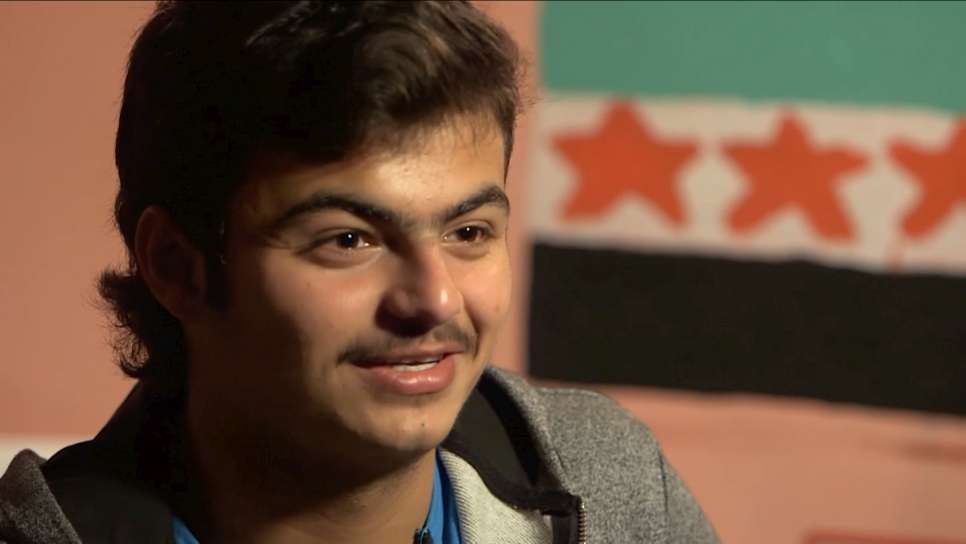Teaching materials ages 15-18
Group and individual work is encouraged along the way to foster a sense of academic independence with check-ins by teachers.
Click on links below to download the teaching materials. You can use the video exercises, guides and lesson plans as you see fit. Download the Teaching About Refugees Lesson Plan template to prepare or use your own lesson planning tools.
Basic concepts
In this age group, we recommend that you start by teaching your students basic concepts of the topic of refugees, asylum and migration, since this will provide the basis for further learning on the subject.
STEP 1 - Watch the animations
We recommend that you and your students first watch the explainer videos on refugees, migrants, internally displaced people and asylum-seekers (in that order).
STEP 2 - Put the animations and teaching sheets together
Use the corresponding teaching sheets to put together a lesson plan. For each basic concept focus on where people are (in their own country or not), why they are where they are (reasons for being displaced or migrating) and what their rights are. Each video activity takes around 15 minutes. You can combine the videos as you see fit with other teaching materials.
STEP 3 - Hold a class debate
For older students or for classes that are more appropriate for debate, you can use the class debate sheets to organize a group discussion on the topics in the animations.
Internally displaced persons
Internally displaced people are seeking safety in other parts of their country.
Asylum-seekers
Asylum-seekers are people seeking international protection from conflict and persecution.
Research and critical thinking
For this age group, you can start including research and critical thinking exercises into your lesson planning. Read through the Facts matter section and Eye-openers section of this web page again if needed and put together a lesson using the elements below. You can adapt the length of your lesson as you see fit.
STEP 1 - Figures at a glance
More than 82 million people are displaced today. This is the highest number since the end of WWII. But who are the people behind these staggering statistics? Do some 'wild guessing' activities suggested in this teaching sheet and find out about numbers of refugees, asylum-seekers, internally displaced people and stateless persons, their countries of origin and host countries. Activities take around 10 minutes.
STEP 2 - Where do refugees come from?
More than half of the world’s refugees come from just three countries: Syria, Afghanistan and Somalia. Take a map and do the map exercises, watch the animation and use the teaching sheet to find out where most refugees come from. Activities take 10-30 minutes.
STEP 3 - Where are displaced people?
Almost 9 out of 10 refugees are in the developing world. Most are in neighbouring countries. Activities take 10-30 minutes.
STEP 4 - Refugee rights
There are international rules on the protection of refugees. One of the basic principles is that people who have fled because of violence, war or persecution cannot be sent back to their country if this puts them at risk. Watch the animation and use the teaching sheets to find out about refugee rights. Activities take 10-30 minutes.
School activities
To bring the complex subject of refugees, asylum and migration closer to the daily life of 15-to-18-year-olds and to move them into action, you can choose a couple of activities from the school activity guide below. The activities vary in length and can be integrated into many teaching settings and locations in and around your school.
To find out more about who is helping refugees, watch the animation and read the article.
'Path Out' video game
If you have computers with an internet connection available for each individual student, give them some time to play the video game 'Path Out'.
'Path Out' takes players through the experience of young Syrian refugee Abdullah Karam, a computer game designer who fled his country and settled in Austria, where he is now working as a programmer and designer.
The game takes about half an hour and can be played in a simple web browser (cf. Google Chrome, Safari, Firefox). Access it via this link.
If you want to work the game into a longer lesson of 50 minutes - one hour, do some class activities suggested in the learning activities.
- Download learning activities for the video game (available soon)
Video exercise
Watch this video with your students and use the video exercise lesson plan to do a couple of activities and ask a few questions. You can vary the length of the activity as you like. Activities take 15-30 minutes.
Omar's story
Omar is seventeen. His father Ziad and his mother Maha and his three brothers and two sisters fled Syria to Jordan, where they lived as refugees for e few years. Omar recalls how he and his father had to do all kinds of work just to survive. The family was eventually resettled to Luxembourg. Omar now goes to school like any other 17 year old. He is passionate about fitness and documenting his surroundings with his own camera.







